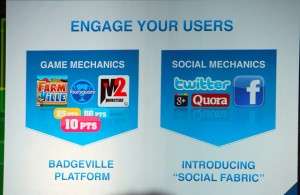
One of the buzzwords you heard the most in 2011 was “gamification“. It has no real definition, meaning it’s not in the dictionary as of yet, but the trend to turn everything into a game somehow has definitely caught on.
Adding badges, leaderboards, and simple turn-based gaming elements to any site is fast becoming to go-to approach for increasing engagement on anything from news sites to consumer shopping sites.
Badgeville, a company that provides a gamification platform for enterprise customers, has seen tremendous growth this year, 400% to be exact. With over one hundred new customers this year alone, including Dell, Samsung, and eBay, the company is showing the world that by adding a few social gaming elements to your online presence, you can increase engagement and increase profits. You’ve even seen Badgeville elements here on The Next Web.
Not sold yet? For its customers, Badgeville increased social sharing by 200%, user-generated content by 50%, and paid conversions by 10%. That’s one heck of a game.
Gamification in 2012
I had a chance to interview Badgeville CEO Kris Duggan about this year and beyond for his company and gamification as a whole:
TNW: Many think that gamification was a fad for 2011, what have you seen that says otherwise?
 Kris Duggan: If gamification was a “fad” in 2011, it’s grown up to become a real, sustainable business strategy for 2012. We think of gamification as one piece of measuring and influencing user behavior, in a larger picture of Behavior Lifecycle Management. Gamification alone is just getting started. In the past year, we’ve added over 100 customers including dozens of the world’s largest Fortune 1000 companies.
Kris Duggan: If gamification was a “fad” in 2011, it’s grown up to become a real, sustainable business strategy for 2012. We think of gamification as one piece of measuring and influencing user behavior, in a larger picture of Behavior Lifecycle Management. Gamification alone is just getting started. In the past year, we’ve added over 100 customers including dozens of the world’s largest Fortune 1000 companies.
Gartner estimates 70 percent of Global 2000 businesses will be gamified by 2015. Our customers, from Dell to Samsung to The Active Network to The Next Web (TNW was one of Badgeville’s first customers), understand that gamification is not about tacking on a few points and badges to an online experience. The best gamified experiences, whether designed to drive customer or employee behavior, are deeply integrated across your brand’s online experience, not hidden in one section of your site or used in a short-term campaign. When you think of gamification as a holistic, long-term experience that includes social rewards, reputation systems, and social experiences on your site, it is clearly not a fad, but a change in the way businesses think about driving user behavior and reaching their key objectives defined by this behavior.
TNW: What made you get into enterprise gamification in the first place?
Kris Duggan: My interest in enterprise gamification stemmed from a day when I was using Google Analytics for another project I was working on, and realized that it didn’t make sense that all the rules you set up for measuring behavior are hidden from your audience. If you have objectives that you want people to do, why don’t you share them with your users? We started looking at how to build the next generation of analytics, which provide transparency to your audience of your business objectives. Then we looked at the programs that are successful in driving behavior.
Social games, at the time reaching their early rise of popularity, were achieving success clearly due to their understanding of how to tell users what to do, and reward them for these behaviors. Drawing on my experience in enterprise software, I saw early on that many of these techniques working so well for social gaming experiences, when taken out of the gaming context, would be successful in measuring and influencing user behavior across the enterprise. I didn’t necessarily think of it as “gamification” at the time, but a combination of proven techniques from social gaming, loyalty, enterprise software and analytics, that could help serious businesses reach their user- and employee-driven objectives.
TNW: You’ve seen 400% growth in 2011, what other numbers can you share to show how huge that is?
 Kris Duggan: Badgeville, just over a year old, is now serving over 1 Billion API calls per month across over 100 global customers. Our customers are seeing very significant results, such as 10 percent increase in paid conversions, 20 percent increase in lifetime user value, 55 percent increase in user-generated content, and 200 percent increase in social sharing.
Kris Duggan: Badgeville, just over a year old, is now serving over 1 Billion API calls per month across over 100 global customers. Our customers are seeing very significant results, such as 10 percent increase in paid conversions, 20 percent increase in lifetime user value, 55 percent increase in user-generated content, and 200 percent increase in social sharing.
Our gamification and behavior lifecycle management solutions are interoperable with over 35 third-party platforms. We have raised $15M in the last year and have over 50 employees from Zynga, Playdom, Salesforce.com, WebEx, American Express, Lithium, Jive Software and more, in three offices around the world, including our headquarters in Silicon Valley, and teams in New York and Europe. We’ve been recognized by many prominent awards, including recently being named one of Forbes Most Promising Companies in America.
TNW: What are your plans for 2012?
Kris Duggan: The next year will be a very exciting time for Badgeville. We plan to continue scaling our company to support growing demand from enterprises for gamification solutions designed for serious businesses. I am looking forward to our upcoming customer launches, building our team (we plan to double our size in 2012), and helping continue educate the market about the true business value of enterprise gamification programs. Look for us to announce exciting new products to help measure and influence behavior, as well as new ways our customers are applying gamification techniques to drive behavior with Badgeville’s Behavior Platform.
Will people get badge fatigue? It doesn’t seem like it. Zynga just went public today, so social gaming is more than likely here to stay. Whenever a trend kicks up profit for enterprise like gamification has, it means that it’s an area that will see more players, more investment, and more interest as time goes on.
Get the TNW newsletter
Get the most important tech news in your inbox each week.




